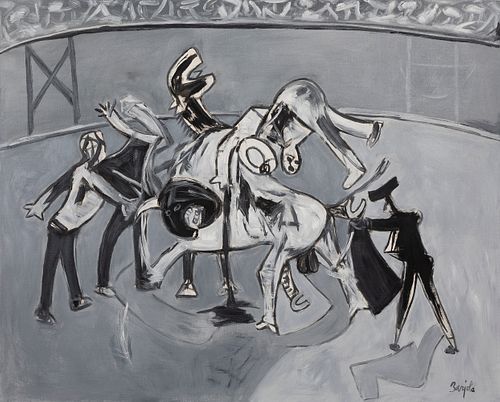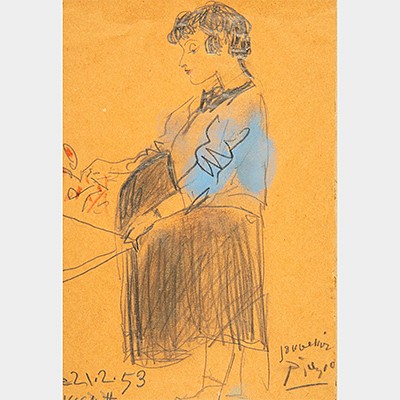JUAN BARJOLA (Torre de Miguel Sesmero, Badajoz, 1919 - Madrid, 2004). "Bullfighting". Oil on canvas. Signed in the lower right corner. Work verified b
Lot 81
About Seller
Setdart Auction House
Carrer Aragó 346
Barcelona
Spain
Setdart Subastas was born in 2004 and is currently the first online art auction in Spain with solidity, prestige and reliability guaranteed by our more than 60,000 users. Setdart has a young, dynamic and enterprising team ready to successfully manage the purchase and sale of art works through custom...Read more
Estimate:
EUR€40,000 - EUR€50,000
$43,478.26 - $54,347.83
Absentee vs Live bid
Two ways to bid:
- Leave a max absentee bid and the platform will bid on your behalf up to your maximum bid during the live auction.
- Bid live during the auction and your bids will be submitted real-time to the auctioneer.
Bid Increments
| Price | Bid Increment |
|---|---|
| EUR€0 | EUR€10 |
| EUR€200 | EUR€25 |
| EUR€500 | EUR€50 |
| EUR€1,000 | EUR€100 |
| EUR€3,000 | EUR€200 |
| EUR€5,000 | EUR€500 |
| EUR€10,000 | EUR€1,000 |
| EUR€20,000 | EUR€2,000 |
| EUR€50,000 | EUR€5,000 |
About Auction
By Setdart Auction House
Sep 20, 2021
Set Reminder
2021-09-20 08:00:00
2021-09-20 08:00:00
America/New_York
Bidsquare
Bidsquare : CONTEMPORARY ART
https://www.bidsquare.com/auctions/setdart-auction-house/contemporary-art-7482
Setdart Auction House sofia@setdart.com
Setdart Auction House sofia@setdart.com
- Lot Description
JUAN BARJOLA (Torre de Miguel Sesmero, Badajoz, 1919 - Madrid, 2004). "Bullfighting". Oil on canvas. Signed in the lower right corner. Work verified by Juan Antonio Galea, son of the artist. Measurements: 81 x 100 cm; 103 x 122 cm (frame). Barjola endows his Tauromaquias with an infamous sense, transmitting the tragedy of the art of bullfighting through a language inherited from Goya and Picasso, who already captured in their engravings their particular vision of this theme. According to Fernando Castro, an expert on the figure of Barjola, "The infamous visions of Barjola, gifted with an incredible capacity to capture existential nausea, have an obsessive rhythm, returning to inhospitable places, be it the bullring where the commotion occurs after the bullfight or the brothel where the bodies deliver, more than anything else, disgust". Barjola, who knew how to synchronize the currents of cubism and expressionism, develops in his bullfights the dislocation of the figures. Castro affirms "Barjola turns his tauromaquias into strange swirling compositions, paying enormous attention to the third of rods. In these catastrophic tauromaquias, the horse is almost always cast in the role of the propitiatory victim, swiftly dragged to death by an action to which it is oblivious, an action in which the horse is innocent. That is why there is always a supreme gesture of pain, of protest, of supplication". Belonging to the current of representative expressionism, Juan Barjola is one of the most outstanding Spanish painters of the second half of the 20th century. Already as a child he showed his love for drawing. At the age of fifteen he arrived in Badajoz to begin his training at the Escuela de Artes y Oficios of the city. In 1943 he moved to Madrid, where he first studied at the Escuela de Artes y Oficios and later at the Escuela Superior de Bellas Artes de San Fernando. At the same time, he furthered his education at the Prado Museum. During this period, which ended in 1950, Barjola made a series of academic works of naturalistic style, with themes taken from family life, suburban characters and other genre scenes. Around 1950 he began a new stage of post-cubist style, a prevailing trend in Madrid due to the influence of Daniel Vázquez Díaz. During these years Barjola would develop faceted images, with flat treatment and bluish and cold colors. At the same time he began to develop a new, more constructive stage, marked by earthy colors. In 1957 Barjola made his debut at the Abril Gallery in Madrid, and that same year he held two more personal exhibitions in Brussels. He then began a brilliant exhibition career that would take his work to Europe, Japan, the United States and Latin America. Around 1958 he began a short but intense period in which he experimented with a language of abstract tendency. His work will now be marked by thick and sumptuous impastos of sordid and dark colorations, which form abstract and organic still lifes. It is the moment of apogee of the material abstraction led by Tàpies from Barcelona. A year later, and without disappearing the thick impastos, the organic stains begin to be resolved in human embryos, the result being a return to figuration in line with the international trend initiated by Francis Bacon. Barjola thus became the main Spanish representative of the New Figuration. At the same time, his work became more and more recognized. Towards 1964 his work underwent a new evolution, marked by the paintings of Velázquez, Goya and El Greco. Thus began the Golden Age of the painter. The thick impasto disappears and his language becomes more fluid, while his colors acquire brightness and luminosity. At the same time, Barjola created a series of works of brutal expressionism and great visual power, linked to the themes of violence and war. However, by 1972 his painting began to leave behind this conceptual weight to open up to a more purely plastic experimentation, in which form, composition and color became the protagonists. This change leads, in the eighties, to a painting marked by a decorative sense and a lighter lyricism and optimism. All the drama of his work disappears, and the paintings become celebrations of light, color and movement. It was at this time that he was awarded the Premio Nacional de Artes Plásticas (1985). However, in the following decade Barjola would return to dramatic expression, leaving aside formal experimentation to focus on an implacable pessimism, directing his painting towards what had always been his artistic credo: the expression of human drama. After his death in 2004, important exhibitions have been dedicated to him, such as the retrospective held at the IVAM in Valencia in 2006. He is currently represented in the Museum that bears his name in Oviedo, the Reina Sofía in Madrid, the Fine Arts Museum of Bilbao, the Museum of Fine Arts in Madrid, the Museum of Fine Arts in Madrid and the Museum of Fine Arts in Madrid.
- Shipping Info
-
In-house shipping available. Please inquire at admin@setdart.com.
-
- Buyer's Premium



 EUR
EUR CAD
CAD AUD
AUD GBP
GBP MXN
MXN HKD
HKD CNY
CNY MYR
MYR SEK
SEK SGD
SGD CHF
CHF THB
THB



















